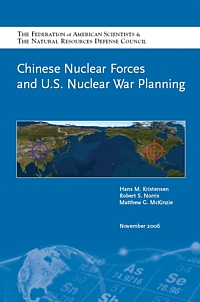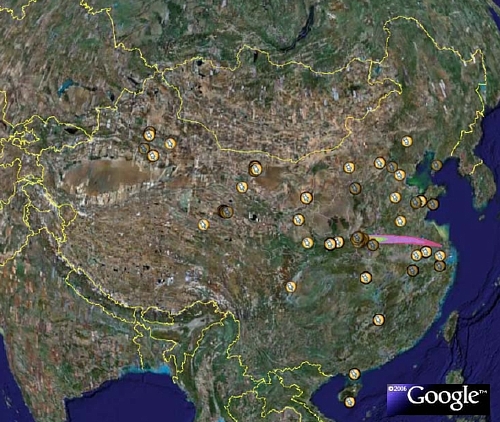 |
| ISBN 0-9653386-451500 |
Report:
Chinese Nuclear Forces
and U.S. Nuclear War Planning
November 30, 2006
China and the United States are in a
nuclear arms race. Not an arms race of the intensity and proportions of
the U.S.-Soviet arms race during the Cold War, but an arms race
nonetheless. The U.S.-Chinese adversarial nuclear relationship goes back to the
Korean War, but the scope and sophistication of the race appears to be
increasing.
In parallel with a modernization of military forces in
general, both countries are upgrading their nuclear forces with an
eye to what the other is doing. The political establishments on both
sides of the Pacific - and some media and private institutes - are
busy highlighting the other country as a threat.
In doing that, Chinese Nuclear Forces
and U.S. Nuclear War Planning documents how the Pentagon, the
intelligence community, congressional committees, private institutions
and part of the news media frequently exaggerate Chinese nuclear
capabilities and cherry-pick new developments out of context to show a
threat. The examples are then used when advocating increased military
deployments or development of more efficient weapons capabilities to
counter the Chinese threat.
Chinese Nuclear Forces
and U.S. Nuclear War Planning is
written by Hans M. Kristensen,
director of the Nuclear Information Project at FAS, Robert S. Norris,
senior research associate with the NRDC nuclear program, and Matthew G.
McKinzie, scientific consultant with the NRDC nuclear program. The
report is published jointly by
Federation of
American Scientists and
Natural Resources Defense Council.
The report examines the debate over
China's modernization of its nuclear forces, reviews the composition and
possible future development of the Chinese nuclear arsenal, describes
past and current U.S. nuclear targeting of China, and uses government
software to simulate the effects of Chinese and U.S. of nuclear attacks.
The report urges China and the United States
to take urgent steps
to halt and reverse the race.
The
report is based on numerous documents obtained under the Freedom of
Information Act, other documents published by the U.S. and Chinese
governments, studies by private institutes, news media reports, other
publicly available information, and high-resolution commercial satellite images.
The 250-page report contains the following
sections, which can either be downloaded individually or as the full
report below or from the right-hand document bar:
-
Cover (PDF, 0.35 MB)
-
Table of Contents and Executive Summary (PDF,
0.28 MB)
-
Chapter 1: The Debate Over China's Nuclear Modernization (PDF,
0.27 MB)
- Reviews how the Pentagon, U.S. government agencies, Congress, media and
private institutes describe China's nuclear modernization and
intentions.
-
Chapter 2: Estimates of Chinese Nuclear Forces (PDF,
8.65 MB)
- Outlines the current Chinese nuclear
arsenal based on publicly available sources and new information obtained
under the Freedom of Information Act. Examines the possible future
development of the Chinese arsenal under different assumptions. Satellite images are used to
profile selected Chinese military facilities, some of which have never
been shown in public.
-
Chapter 3: China in U.S. Nuclear War Planning (PDF, 1.00 MB)
- Describes past and current U.S. nuclear targeting of China, using declassified documents and other
information to trace the changes in nuclear strike plans and weapons
deployments.
-
Chapter 4: Simulated U.S. and Chinese Nuclear Strikes (PDF,
1.73 MB)
- Uses U.S. government computer software to simulate U.S. and
Chinese nuclear strikes and calculate the resulting human casualties
and fatalities. Examines effects from possible future Chinese
postures.
-
Chapter 5: Conclusions and Recommendations (PDF, 0.07 MB)
-
Appendix A: Chinese Nuclear Forces, 2006 (PDF, 0.04 MB)
-
Endnotes (PDF, 0.15 MB)
The full report is available
here (PDF,
12.50 MB)
Take Google Earth Trip of Chinese Military Facilities

Making use of the unique capabilities of
the free Google Earth program, FAS and NRDC have designed a virtual trip
of selected nuclear and military facilities in China. Here is how you
use it:
1. Download
Google Earth onto your computer.
2. Click
here or on the map to the right to download the FAS-NRDC Google
file. The program will ask you to either open in Google Earth or
download to your hard drive.
3. When
Google Earth has finished loading on your computer, make sure the
check-box "Chinese Nuclear Forces and U.S. Nuclear War Planning" in the
"Places" window to the left is checked to activate the placemarks.
4. Click once on the first
placemark ("Chinese Nuclear Forces and U.S. Nuclear War Planning") to
open the text "bubble" with information.
5. If all the placemarks have not opened
automatically, click the "plus-box" to the left of the "check-box" in
the "Places" window.
6. Those placemarks with an icon that looks like the
Google Earth logo or a file-folder contain additional sub-placemarks.
Click on the "plus-box" to open each folder. Note that some air bases
contain sub-placemarks for each aircraft.
7. Double-click on each consecutive placemark to
zoom in on each facility. Don't forget to use the "tilt" and "rotate"
functions of Google Earth to get a better view.
8. The last two folders contain graphic displays of
nuclear strike simulations. These simulations are explained in detail in
the
Chapter 4 of the report.
NOTE: Also read the
report blog at
http://fas.org/blog/ssp/
|

